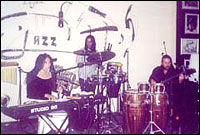12.7.11 Jesús Alemañy

Jesús Alemañy is a prominent Cuban Latin jazz trumpeter and bandleader, born in the capital city of Guanabacoa. He felt a strong musical inclination from a very early age and began playing in carnival groups in his hometown at just fifteen years old.
Years later, he joined the musical group “Sierra Maestra,” with whom he performed successful international tours that included several countries in South America and Europe, as well as Japan.
In 1995 he joined the group Cubanismo as a trumpet player and director, which emerged as a recording project of talented figures of Cuban music. Cubanismo also includes singers Rolando (“Rolo”) Martinez Lopez, Jesus Cantero Llanes and Hidelgardi Vazquez Suarez (“Gardi”), Carlos Luis Alvarez Guerra on trombone, Pabloski Rosales Peñalver on tres, Eduardo Felipe Lavoy on bongo, Jose Espinosa (“Pepe”) on timbale, Jorge Luis Torres (“Papiosco”) on congas, Rolando Perez Perez on saxophone, Eduardo Elier Rodriguez on trumpet, Jorge Emilio Masa on flute and saxophone, Roberto Riveron Mederos on bass and Rodolfo Argudin (“Peruchin”) on piano.
Directed by Jesús Alemañy and produced by Mr. Joey Boyd, Cubanismo has released five albums under the European record label Hannibal Records.
In 1996, the group’s debut album reached number ten on the Billboard Salsa and Tropical charts. This album was followed in 1997 by Melembe, and in 1998, they released the highly successful album “Reencarnación.” Considered a masterpiece, it embraces the musical fusion tradition of Havana and New Orleans. In 2000, Cubanismo released its album “Mardi Gras Mambo.”
At the end of 2001 they selected the most brilliant interpretations from their previous discography to record the CD “Mucho Gusto” to which they added two titles composed by Bob Marley: “Could You be Loved” where the participation of the reggae singer Luciano stands out and the song “Get Up, Stand Up” with the collaboration of the Jamaican guitarist Ernest Ranglin.
Jesús Alemañy currently resides in London, but his Cuban roots are clearly expressed through Cubanismo, a group that he defined in an interview with Americasalsa.com: “As a culmination of traditional Cuban music, traditional rhythms with a modern sound, where mambo, cha-cha-chá, bolero, and danzón coexist—in other words, a combination of instrumental and danceable music.”








